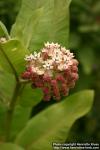 Related plants: Asclepias Incarnata.—Flesh-Colored Asclepias - Asclepias (U. S. P.)—Asclepias
Related plants: Asclepias Incarnata.—Flesh-Colored Asclepias - Asclepias (U. S. P.)—Asclepias
The root of the Asclepias Cornuti, Decaisne (Asclepias syriaca, Linné).
Nat. Ord.—Asclepiadeae.
COMMON NAMES: Common milkweed, Silkweed, Wild cotton.
Botanical Source.—The common milkweed has a large, stout, simple, somewhat branched stem, growing from 2 to 5 feet high. Its leaves are ovate-elliptical, spreading, opposite, with short but distinct petioles, gradually acute, tomentose beneath. The flowers are fragrant, arranged in several axillary, subterminal, nodding, dense, globose umbels, each of 20 or more flowers. The calyx segments are lanceolate. The corolla is pale or greenish-purple, reflexed, leaving the corona, which is of nearly the same hue, quite conspicuous. But few of the flowers prove fertile, producing oblong-pointed pods or follicles covered with sharp prickles, which contain a mass of long, silky fibers with seeds attached, and which fibers have been used for beds, pillows, and in the place of fur in manufacturing hats.
Description.—This rhizome grows from 1 to 6 feet in length, and is cut into transverse pieces or slices about ¼ inch or ½ inch in diameter. The root is cylindrical, finely corrugated, tough, has a somewhat knotty appearance from stem-scars, or partially formed branches, and breaks with a short, splintered fracture. Externally it is grayish-brown; internally white. Its white bark is thick and surrounds a yellowish, porous, woody center, and contains lactiferous channels. It has scarcely any odor, but its taste is disagreeably bitter.
History and Chemical Composition.—This herb is indigenous to the United States, inhabiting rich soils, uncultivated fields, roadsides, etc., and bearing whitish-purple, or rather dull, pinkish-purple flowers from June to September. When wounded it emits a milky fluid, which contains water, wax-like fatty matter, gum, caoutchouc, sugar, various salts, etc. A crystalline, resinous substance, has been obtained from the juice of the A. Cornuti, to which the name of asclepion has been given. It is procured by boiling and then filtering the juice, and separating the asclepion from the filtrate by ether, from which it may be subsequently obtained by evaporation, and purified by several washings with pure ether. Asclepion thus obtained is a crystalline solid, without taste or smell, and is readily dissolved by spirits of turpentine, pure acetic acid, and sulphuric ether (C. List, 1849).
Tannin, gummy material, ash, and a small quantity of volatile oil were found in the root by Mr. W. L. Hinchman, in 1881, who also obtained, in an impure state, a bitter principle. A volatile principle of an acrid character is said to reside in the fresh root. Quackenbush obtained a crystalline glucoside similar to that which he obtained from pleurisy root, but failed to find tannin (Amer. Jour. Pharm., 1889). Starch is present in the parenchymatous portion of the root.
Action, Medical Uses, and Dosage.—The root of this plant is tonic, diuretic, alterative, emmenagogue, purgative, and emetic; and given in large doses it is stimulant and anthelmintic. Dr. Richardson has attributed anodyne properties to it, but he must have had reference to some other plant. It has, however, recently been revived as a remedy for muscular rheumatism, some claiming it to be as effective as macrotys. It should be studied in this connection. It has been found useful in amenorrhoea, dropsy, retention of urine, asthma, dyspepsia, cough, dyspnoea, constipation, primary syphilitic disease, worms, scrofulous and rheumatic disorders. The action of the heart is augmented under its use. A very excellent fluid extract may be made from it as follows: To 16 troy ounces of the recently dried root, finely bruised, add 6 fluid ounces of ether and 4 fluid ounces of alcohol; form a tincture by slow percolation, and set it aside. Then thoroughly exhaust the root by percolation, with 6 fluid ounces of alcohol and a sufficient quantity of water; evaporate this last over a water-bath, add the first tincture, made with ether and alcohol, to it, and reduce by evaporation to 1 pint. An aromatic, bitter, red fluid extract is thus obtained, of which 1 fluid drachm is equal to 1 troy ounce of the crude root. The dose is from 10 drops to 1 fluid drachm; it may be taken in ginger syrup, lemon syrup, cinnamon water, or other pleasant vehicle, to cover its unpleasant taste. Dose of the powder, 10 to 20 grains; of the decoction, 2 to 4 fluid ounces; of the tincture, 10 to 60 minims.

